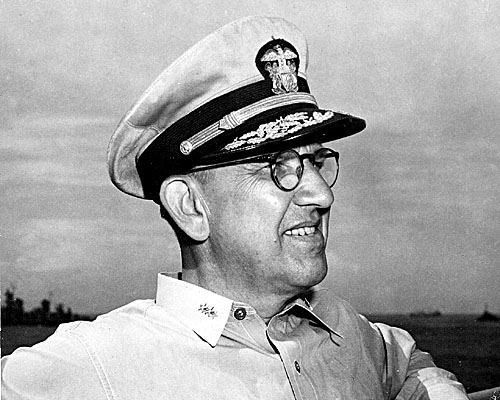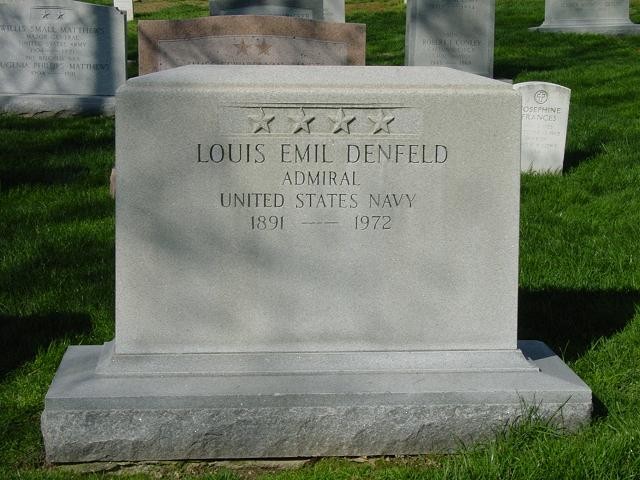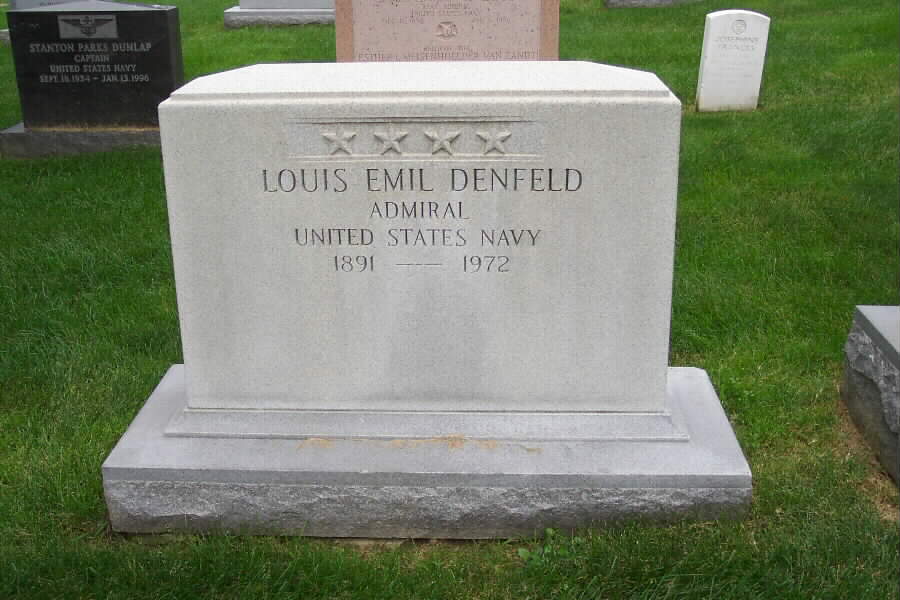Courtesy of the United States Navy:
Louis Emil Denfeld (13 April 1891-28 March. 1972), Admiral and Chief of Naval Operations, was born in Westborough, Massachusetts, the son of Louis Denfeld, an attorney, and Etta May Kelley Denfeld.

Received From Bill Gonyo
Denfeld graduated from Duluth (Minnesota) High School in 1908, was admitted to the U.S. Naval Academy that year, and graduated as an Ensign four years later. Following routine assignments aboard the battleships USS Virginia and USS Arkansas, he served on a destroyer.
During World War I he was stationed at Queensland, Ireland, as Executive Officer of the USS Ammen, and in 1918 he advanced to temporary Lieutenant Commander.
After the war Denfeld reported to Boston, served several years as inspector of the Navy’s New England Division, and fulfilled additional service aboard destroyers and submarines. In 1924 he began his long association with staff service by joining the ship movements division at the Office of the Chief of Naval Operations, residing there two years. In 1929 he returned to Washington, D.C., as aide to the Chief of Navigation. In 1933 he was promoted to Commander while serving as secretary to Admiral Richard Henry Leigh. Four years later he joined the staff of influential Chief of Naval Operations William D. Leahy, who took a keen interest in his advancement. Having risen to captain in 1939, Denfeld assumed command of Destroyer Squadron One the following year, just prior to performing detached service as a special naval observer in London.
Returning in April 1941, Denfeld took his post as Chief of Staff to the Commander of the Atlantic fleet. In this capacity, he was charged with developing a task force organization to safely escort convoys across the Atlantic. His planning proved so sagacious that he received the Legion of Merit.
The December 1941 attack on Pearl Harbor accelerated Denfeld’s rise up the chain of command and enhanced his reputation for efficiency. Commencing in April 1942, he became a Rear Admiral and was appointed Assistant Chief of
the Bureau of Navigation, subsequently redesignated the Bureau of Personnel. There he remained until the spring of 1945, when he was given command of Battleship Division Nine. In this capacity Denfeld directed the fire of the
three ultramodern battleships–USS Wisconsin, USS New Jersey, and USS Missouri–throughout the Okinawa campaign. By war’s end, his ships were bombarding the Japanese coastline.
Soon afterward he returned to Washington, D.C., as head of the Bureau of Personnel with the rank of Vice Admiral. Denfeld next became charged with postwar demobilization, which he handled with characteristic energy and dispatch. By 1947 he was at sea again as Commander in Chief, Pacific, with the rank of full Admiral. That fall Admiral Chester Nimitz announced his intention to resign as Chief of Naval Operations (CNO), and Denfeld, assisted by his former mentor Admiral Leahy (now chairman of the Joint Chiefs of Staff) succeeded him, edging out Admirals William H. P. Blandy and Arthur W. Radfield.
Denfeld was widely regarded as a gifted administrator; however, his tenure as CNO proved unsatisfactory. The U.S. defense establishment was then experiencing postwar fiscal retrenchment, further exacerbated by the onset of the Cold War with the Soviet Union. The traditional rivalry between military and naval concerns was also complicated by the creation of an independent U.S. Air Force in September 1947. The development of jet aircraft and atomic weapons had convinced many in defense circles that the traditional role of the U.S. Navy was obsolete. Denfeld and Navy Secretary John L. Sullivan resisted all attempts to reduce navy expenditures or curtail its strategic mission. Both were also determined to preserve naval aviation and prevent the U.S. Marine Corps from being absorbed by the Air Force and army under the scheme of defense unification. To this end, Denfeld became a vocal proponent of the United States, the nation’s first super carrier, expressly designed to operate jet aircraft. Moreover, because many of these aircraft were nuclear-capable, he intended such ships to break the air force monopoly on atomic weapons delivery. Denfeld and Sullivan were initially successful, and in 1948 both Congress and President Harry S. Truman approved funding for the new carrier over strenuous objections from Air Force officials. But, in view of stringent funding caps, Denfeld had to scrap thirteen other vessels under construction to fund the United States.
By 1949 the Berlin airlift and the creation of the North Atlantic Treaty Organization (NATO) had enhanced Air Force arguments against the funding of super carriers. Because air force bombers could now operate off European airfields well within range of Soviet targets, carrier aviation was increasingly viewed as superfluous. Critics of an independent navy were supported by a new secretary of defense, Louis A. Johnson, who had a personal dislike for the navy and its officers. Accordingly, Johnson managed to cancel the United States, even though its keel had been laid. This action triggered an internecine struggle within the War Department. The resulting “revolt of the admirals” comprised a wholesale attack by the navy upon air force procurement of the massive Convair B-36 bomber, which had become the centerpiece of Johnson’s policies. In the midst of the turmoil, Denfeld left Washington to visit Europe in connection with ongoing NATO affairs. His presence was missed during intense deliberations before the House Armed Services Committee, and the navy failed to have its super carrier reinstated. Worse, in September 1949 Denfeld unofficially endorsed a letter, penned by a subordinate, which maintained that navy morale was at its lowest since 1916. When the letter was leaked to the press, Johnson, already angry at Denfeld for testifying against the B-36, agitated for his removal. Truman had already agreed to appoint him for another two-year stint as CNO but eventually demanded his resignation, which was received on 28 October 1949. As a sop to the discredited admiral, Johnson offered Denfeld a high-ranking naval post in Europe, but he declined and retired from active service in March 1950. He was succeeded by Admiral Forrest P. Sherman.
Denfeld’s views on the flexibility of naval aviation, when contrasted with the military inflexibility of strategic bombing, was vindicated during the Korean War, 1950-1953. In an age of limited war, strategic air power and atomic weapons became irrelevant to the tactical situation at hand, while jet-powered carrier aircraft demonstrated both utility and effectiveness for battlefield strikes and supply-line interdiction.
Back in civilian life, Denfeld served as an advisor to Sunoco (Sun Oil Company) from 1950 to 1971. He died at his home in Westborough, Massachusetts, and was interred at Arlington National Cemetery. Denfeld married Rachel Metcalf in June 1915; they had no children.
Denfeld died at Westboro, Massachusetts, on March 18, 1972 and was laid to rest in Arlington National Cemetery (Section 30, Grave 433)
DENFELD, LOUIS EMIL
ADM USN
- DATE OF BIRTH: 04/03/1891
- DATE OF DEATH: 03/29/1972
- BURIED AT: SECTION 30 SITE 433 RH
ARLINGTON NATIONAL CEMETERY
Michael Robert Patterson was born in Arlington and is the son of a former officer of the US Army. So it was no wonder that sooner or later his interests drew him to American history and especially to American military history. Many of his articles can be found on renowned portals like the New York Times, Washingtonpost or Wikipedia.
Reviewed by: Michael Howard


